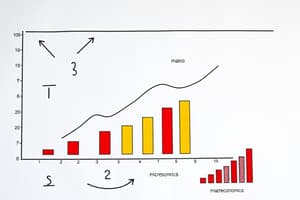Podcast
Questions and Answers
What is the primary focus of microeconomics?
What is the primary focus of microeconomics?
- Assessment of inflation rates across the economy
- Examination of government spending policies
- Analysis of individual agents like households and firms (correct)
- Study of aggregate economic indicators like GDP
Which concept measures responsiveness of quantity demanded to price changes?
Which concept measures responsiveness of quantity demanded to price changes?
- Monetary Policy
- Gross Domestic Product
- Price Elasticity (correct)
- Utility
What does the Law of Demand state?
What does the Law of Demand state?
- As price decreases, quantity demanded increases (correct)
- As price decreases, quantity supplied increases
- Demand and supply are always equal
- Higher prices lead to higher supply regardless of demand
What is a characteristic of a monopoly?
What is a characteristic of a monopoly?
Which economic system combines elements of both market and command economies?
Which economic system combines elements of both market and command economies?
What is the purpose of expansionary fiscal policy?
What is the purpose of expansionary fiscal policy?
Which of the following is an indicator of economic health?
Which of the following is an indicator of economic health?
What does GDP stand for in macroeconomics?
What does GDP stand for in macroeconomics?
Flashcards are hidden until you start studying
Study Notes
Key Concepts in Economics
-
Definition: Economics is the study of how individuals, businesses, governments, and societies make choices about allocating scarce resources.
-
Microeconomics:
- Focuses on individual agents (households, firms).
- Analyzes supply and demand, price determination, and consumer behavior.
- Key concepts:
- Elasticity: Measure of responsiveness of quantity demanded or supplied to price changes.
- Utility: Satisfaction or benefit derived from consuming goods/services.
-
Macroeconomics:
- Looks at the economy as a whole.
- Studies aggregate indicators such as GDP, unemployment rates, and inflation.
- Key concepts:
- Gross Domestic Product (GDP): Total value of all goods and services produced in a country.
- Inflation: Rate at which the general level of prices for goods and services rises.
- Monetary Policy: Central bank actions that manage money supply and interest rates.
-
Supply and Demand:
- Law of Demand: As price decreases, quantity demanded increases, and vice versa.
- Law of Supply: As price increases, quantity supplied increases, and vice versa.
- Equilibrium: Point where supply equals demand, determining market price.
-
Market Structures:
- Perfect Competition: Many firms, identical products, easy entry/exit.
- Monopolistic Competition: Many firms, differentiated products.
- Oligopoly: Few firms, potential for collusion, strategic interactions.
- Monopoly: Single firm dominates market, high barriers to entry.
-
Economic Systems:
- Traditional Economy: Based on customs and traditions.
- Command Economy: Government controls resources and production.
- Market Economy: Decisions driven by supply and demand with minimal government intervention.
- Mixed Economy: Combines elements of market and command economies.
-
Key Economic Indicators:
- Unemployment Rate: Percentage of the labor force that is jobless and actively seeking employment.
- Consumer Price Index (CPI): Measures changes in the price level of a basket of consumer goods and services.
- Balance of Trade: Difference between a country's exports and imports.
-
Fiscal Policy:
- Government's use of taxation and spending to influence the economy.
- Expansionary fiscal policy: Increased spending or tax cuts to stimulate growth.
- Contractionary fiscal policy: Decreased spending or tax increases to slow down growth.
-
Global Economics:
- Trade: Exchange of goods and services between countries.
- Exchange Rates: Value of one currency for the purpose of conversion to another.
- Globalization: Process of increased interconnectedness among countries, economically and culturally.
-
Basic Economic Principles:
- Scarcity: Limited resources vs. unlimited wants.
- Opportunity Cost: Cost of the next best alternative foregone when a choice is made.
- Comparative Advantage: Ability of a party to produce a good at a lower opportunity cost than another.
Definition and Scope of Economics
- Economics studies choices made by individuals, businesses, governments, and societies concerning scarce resources.
Microeconomics
- Analyzes individual agents such as households and firms.
- Key concepts include:
- Elasticity: Responsiveness of quantity demanded or supplied to price changes.
- Utility: Satisfaction gained from consumption of goods and services.
Macroeconomics
- Examines the economy as a whole, focusing on aggregate indicators.
- Important concepts include:
- Gross Domestic Product (GDP): Total value of all finished goods and services produced in a country.
- Inflation: The rate of increase in the general price level of goods and services.
- Monetary Policy: Central bank measures that influence money supply and interest rates.
Supply and Demand
- Law of Demand: A decrease in price results in increased quantity demanded, and vice versa.
- Law of Supply: An increase in price leads to a higher quantity supplied, and vice versa.
- Equilibrium: The market price at which supply equals demand.
Market Structures
- Perfect Competition: Many firms with identical products and easy market entry/exit.
- Monopolistic Competition: Many firms offering differentiated products.
- Oligopoly: Few firms with potential for strategic collusion.
- Monopoly: A single firm dominates the market with high entry barriers.
Economic Systems
- Traditional Economy: Based on customs and traditions.
- Command Economy: Government controls resource allocation and production.
- Market Economy: Decisions made by supply and demand, with limited government intervention.
- Mixed Economy: A blend of command and market economy elements.
Key Economic Indicators
- Unemployment Rate: Proportion of the labor force that is jobless yet actively seeking work.
- Consumer Price Index (CPI): Index measuring price changes of a basket of consumer goods and services.
- Balance of Trade: The difference between a country’s exports and imports.
Fiscal Policy
- Government taxing and spending actions aimed to influence economic performance.
- Expansionary Fiscal Policy: Involves increased public spending or tax cuts to foster growth.
- Contractionary Fiscal Policy: Involves reduced spending or tax hikes to slow economic activity.
Global Economics
- Trade: The exchange process of goods and services between nations.
- Exchange Rates: Measure the value of one currency as it relates to another.
- Globalization: The phenomenon of economic and cultural interconnectedness across nations.
Basic Economic Principles
- Scarcity: The condition of limited resources in contrast to unlimited wants.
- Opportunity Cost: The cost associated with the next best alternative when making a choice.
- Comparative Advantage: The ability of an entity to produce goods at a lower opportunity cost compared to another.
Studying That Suits You
Use AI to generate personalized quizzes and flashcards to suit your learning preferences.




